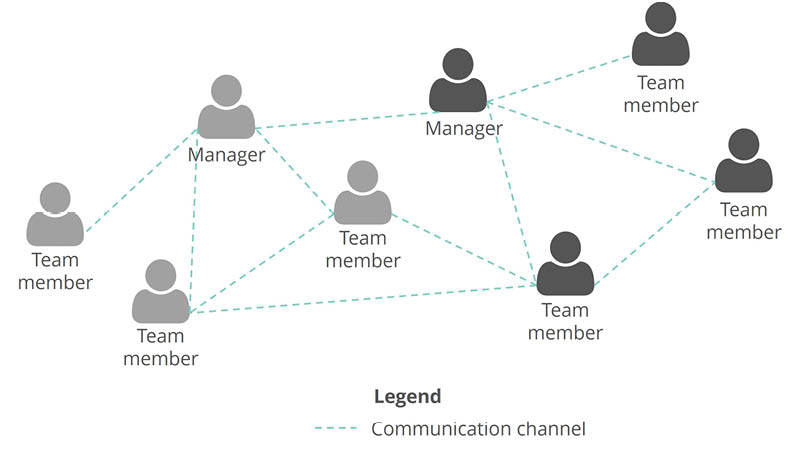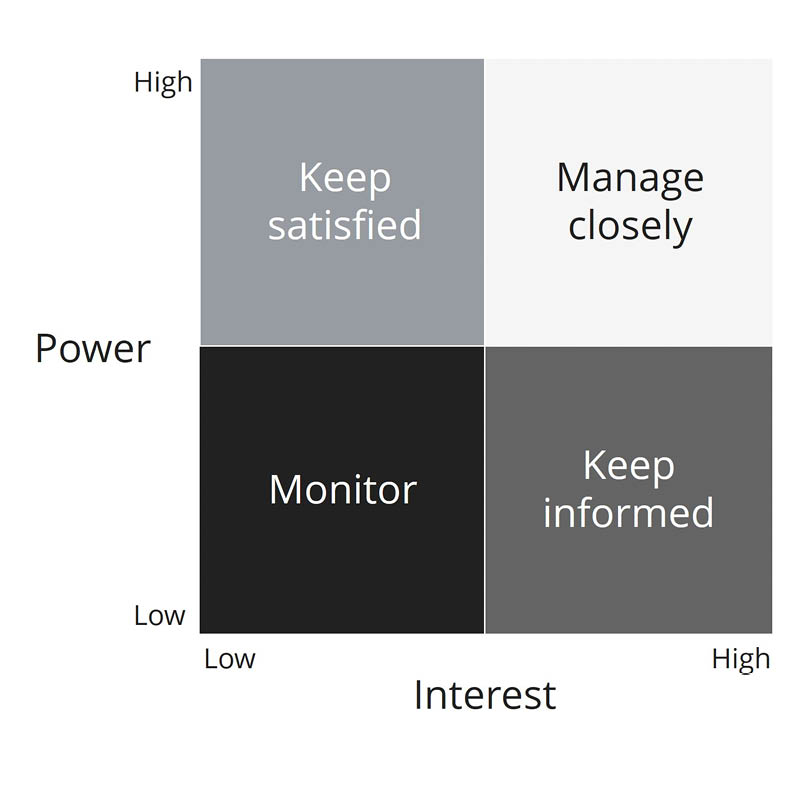

This weekend is all about celebrating relationships so I wanted to spend some time talking about stakeholder analysis, and how you can use it to build your coalition, improve outcomes and make work more fun.
A stakeholder is anyone who is involved in or affected by a course of action. So if you were working on a product development team, the stakeholders could be your customers, suppliers, team members, other departments, and executives.
Stakeholder analysis is a systematic process for identifying stakeholders, understanding their needs in relation to the project, and developing an engagement plan.
It sounds formal but it’s basically just an extension of what you already do in your normal social life. You’ve probably learned a lot about your friends and family over the years. You know about their interests, background, how they like to be contacted, and what kind of communication works well with them vs. tends to cause fights.
The activity is relatively simple but a lot of people just don’t take the time to do it. Skipping stakeholder analysis can cause unnecessary conflicts and missed opportunities to connect and leverage the strengths of people in your change network.
In this post we’ll cover:
- The benefits of doing stakeholder analysis
- The process
- Notetaking options, and
- How to use the information
Benefits of stakeholder analysis
Your interactions will be more effective and less confrontational
If you track your stakeholders’ needs, education, and preferences, you’ll be able to craft a meeting agenda that will resonate with them. Some people make the mistake of showing off everything that they know, instead of crafting the presentation around what the audience currently knows and the information they need to take action. By tailoring the meeting and presentation to the stakeholder, you’ll increase their knowledge retention and have a more positive interaction.
You’ll feel like a superhero
If you’re in a change rut, try stakeholder analysis. It can help you unlock potential and reduce frustration by working with the strengths and weaknesses of team members. Then you can make sure that change team members and stakeholders are in the right roles for their skills and desires.
You’ll run into fewer roadblocks and less rework
By understanding who is interested in and can influence the outcome, you’ll reduce friction that can occur when key people are not informed or as involved in the decision as they feel they should be.
The process
- Identify stakeholders. When you start a project you’ll usually have a list of names and maybe emails. If you’re starting from scratch you might have names of people in your social networks or that you’ve found from forums, articles, websites, companies, etc. Ask around to see if you’re missing any critical players.
- Understand participants and their role in different organizations. Who is part of which group? What role do they play in the group? Is anyone part of multiple groups?
- Review organizational charts (if they exist). Org charts rarely highlight the actual patterns of influence in an organization but they are a good place to start if you’re completely new. You may be able to find one, but if not, try creating one yourself and asking people in the organization for feedback.
- Start to map out communication channels and real influence between different people in the organization or project. You might realize that some people are “connectors” and more influential than the org chart would reveal.
- Research their background, accomplishments, and interests via websites, articles, social media, LinkedIn or other profiles.
- Try to learn about each individual’s personality, hopes, and fears, both how other people see them and how they see themselves. Depending on the accessibility of the person you’re analyzing you might need to settle for anecdotal evidence until you can talk to them personally.
- Get to know them as people. It doesn’t have to be a formulaic questionnaire, just think about natural ways that you can gather this information over time to paint a fuller picture of that person. Lulls in between meetings, happy hours, lunches, and social media are good opportunities.
- Understand how their motivations and personalities may change in different situations. Ex. Stakeholders may act completely different if you are approaching a deadline vs. planning for the long term.
- Update your findings over time. As people’s roles, education, experience, and relationships change you’ll need to update your notes.
Notetaking options
There are a few options for how you can organize your notes:
Excel spreadsheet
Create a column for each category. Ex: name, organization, role, responsibilities, priorities, degree of influence on the project, level of interest in the project, primary concerns, formal engagement strategy, informal engagement strategy, favorite types of artifacts, least favorite types of artifacts, background, interests, desires, fears, etc.
Social network diagram
Draw a symbol for each person and draw lines connecting people to indicate communication channels. You could use an org chart as a starting place, like the example below,

Or jump straight to a social network graph, like this one.

Stakeholder matrix
If you have a lot of stakeholders, a popular way to organize them is by their relative power over and interest in the project. Each quadrant maps to a stakeholder management strategy.

Note: Be careful of what you write in these documents and how you store them in case they are shared and viewed by stakeholders. Your goal is to improve your relationships, not to erode trust. To be safe, write notes that you wouldn’t mind them seeing.
How to use the information
- Share it with team members. Ask them to help you fill in the charts or diagrams. This can be a helpful exercise for onboarding, training, and team bonding.
- Refer to the documents as you plan meetings (ex. kick off meeting or presentation preparation by reflecting on who needs to be there, why, and what their motivations are).
- Do an exercise publicly with the stakeholders involved (ex. ask people to share out loud or write down what they are hoping to get out of the meeting or project). This will help everyone better understand the needs and motivations of others.
- Refer to the document before negotiations to help you brainstorm a potential compromise. You may find that the stakeholders are more aligned in their worldviews than it would seem by their requests.
- Use the document to generate ideas for improvements. If you see a missing or misaligned communication channel, maybe it could be fixed by a weekly meeting, a coffee chat, a new procedure, or a different point of contact.
Stakeholder analysis is a great tool to pull out at the beginning of a project, when the team members have changed significantly, when you’ve hit a rough patch in your relationship, or when you need people to rally around a tough problem.
When you show deep empathy toward others, their defensive energy goes down, and positive energy replaces it. That’s when you can get more creative in solving problems.
– Stephen Covey
What kinds of techniques do you use to better understand the stakeholders in your projects? How has that information helped you or your team?
3 thoughts on “Build better work relationships via stakeholder analysis”
Great article! It’s definitely important to understand personalities and meeting their needs effectively. Otherwise teams spend a lot of time in trying to guess what’s going to work, and putting a lot of effort into each of those guesses.
I’ve seen forethought help cut through some of that waste. But It’s important to document it and use it as a planning tool, as I’ve also seen teams leave behind this kind of understand during times of stress.
Thanks Mike! You’re right, some upfront investment can help avoid a lot of waste later. What do you think causes people to abandon this knowledge during times of stress? What could help keep it in the forefront?
If the approach isn’t ingrained, people will default to old reflexes in times of stress, which can mean leaving behind the new tools they are trying to adopt. So it’s a good discipline to refer frequently to the tools until you don’t need them to jumpstart inclusion in your thinking process. Something like a quick review/reminder before each meeting or engagement with a group. Once you start seeing how it adjusts your communication and interaction, it’s more likely to be something that you reach for, quickly making it a new reflex.
Comments are closed.